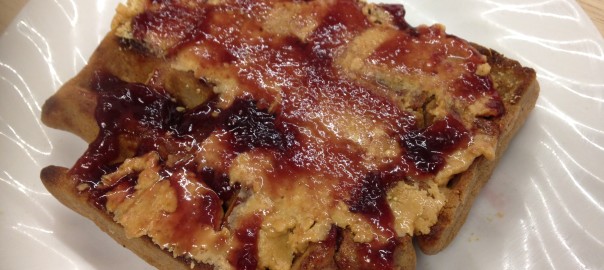You may be shocked to learn that a nutritionist is OK with clients or kids eating waffles. Well, I think that depends on how often, how they are made, what’s in them, and what is the chosen topping. It is a question of moderation…We’re not striving to be perfect, just choosing healthy choices most of the time. These healthy foods can raise the food value of waffles.
I’m willing to offer chocolate chips with a snack, because I mix them with walnuts. It’s a natural mix, slightly bitter walnuts and sweet, creamy chocolate. And the walnuts have a lot of benefits, including protein and helping brain health. (These are soaked and toasted at 150 F until crispy. More about soaking nuts and grains in a later post…)
I thought I would mention a few healthy food additions to your toast, waffles, or PB & J sandwiches that can help them be a little better, without wrecking the “food for the soul” aspect. And these don’t taste bad at all, by the way. You’d hardly notice these additions!
Peanut Butter
We add peanut butter to increase the protein. This slows down the digestion of the white flour and sugar into the blood sugar. The slower intake means that the blood sugar rise is slower, which means less insulin is released. It also avoids an over-release of insulin, which can happen if our blood sugar is skyrocketing. This is great, because insulin damages blood vessels, and some people believe that is the cause of arterial plaque. Slow and steady is important with our meals. Other nut butters would work well, too, or just eating them on the side as whole nuts. (See anti-nutrients below for info about nuts and seeds.)
I know we all like jam and maple syrup, but watch out for those. They tend to digest very quickly, which means they are spiking our blood sugar. Then our bodies release insulin to lower the blood sugar to a safer level. Constant swings of blood sugar from too high to too low can help set us up for insulin resistance and diabetes down the road. Not fun! But adding protein, or fat, or substituting some flour for nut flour or whole grains can help slow the absorption of the waffle.

Four food additions to boost the nutrition of waffles, PB& sandwiches, and toast. Jars of peanut butter, probiotic powder, ground flax seed and fruit-sweetened jam.
Probiotics:
I sprinkle on a little powdered probiotics on top of the peanut butter, and spread it in with a knife. Then I add a fruit-sweetened jam on top. If you are choosing one probiotic, rotate among a few brands, and don’t fall into the trap of “this is the ONE bacteria.”
Most of us are apparently low on both the amount of healthy gut bacteria that we have, as well as the diversity. A lab tech told a naturopath that I know that most people only have about 10% of the gut flora that they should have. Why, you ask? According to Dr. McBride, we’ve had three to four generations using antibiotics, which kill off ALL bacteria, not just the ones causing illness. In addition, we moved away from farms and homemade fermented foods, which used to be common for food preservation.
Ground Flax Seed (Fresh):
I mix some ground flax with peanut butter to help sooth the gut lining, hoping to lessen constipation. When flax seeds moisten, they become a wet, slick substance. It’a called “mucilaginous” in the herbal world.) I am hoping this will help with constipation, but so far it’s not clear-cut if it’s working. However, there are other good things in flax…
Freshly ground flax seed is a source of plant-based Omega 3 Essential Fatty Acid (EFA’s). Most of us are extremely short on Omega 3’s because we and our meat animals both get a ton of Omega 6’s from ingesting grains and beans. (Read more about why it’s important to keep them Omega 3 and Omega 6 in balance, and find more Omega 3 food sources.)
There is some debate as to whether it converts well. Meat-based Omega 3’s convert to both EPA and DHA, which are used in the brain for health. I just learned that flax may only convert well to EPA. So, good, but not the best, especially if you are a vegetarian. (Read more here about flax nutrition.)
Also, it can go rancid easily, so its better to grind it yourself, and use within a few days. Keep it cold in the fridge.
Anti-nutrients:
Since flax is a seed, it really should be soaked for 7 or 8 hours to neutralize enzymes in the seed that stop them from being digested. The phytase enzyme stops digestion, binds with vitamins and minerals, and sweeps them out of the body.(Then its called phytic acid.) This also applies to nuts, beans and grains.
The Mayo Clinic suggest using flax ground instead of whole to increase nutrient absorption. The whole seeds may just pass through undigested.
I figure that using a little will be OK here, because my goal is more to get oil and mucilage into the digestion, instead of providing nutrition. (Read more here about anti-nutrients and phytic acid.)

Plate with peanut butter, probiotic powder, ground flax seed and fruit-sweetened jam.
Butter
We sometimes put butter under the peanut butter, and skip the jam. Butter from all dairy animals is a source for vitamin A. There’s 10% of your daily Vitamin A per ONE Tablespoon. Butter is also a source of vitamins D, E and K. And its highly absorbable, like all animal sources. Vitamins from vegetable sources have to be converted before use, and that depends on other vitamins. (cite 3)
Fats from butter of cows and goats have anti-microbial properties, protecting “us from viruses, yeasts and pathogenic bacteria in the gut.” (Nourishing Traditions quote) These milks are meant to raise kids and calves, with immunity built-in, similar to human milk.
If you choose to buy grass-fed, or pastured” butter, the nutrition increases. The rich buttery yellow heaven also contains Omega 3 EFA’s, of which most of us need much more. Many health food stores carry it. In Colorado we have Kerrygold, Strauss for yogurt, and Kalyna, but I don’t know if the latter makes butter. See the Weston A. Price Foundation list of local chapters to locate a dairy near you, request their shopping guide, or visit www.RealMilk.com to find dairies.
If you are concerned about saturated fats and cholesterol, please read one of the books in the Citations below.
MCT Oil (Liquid Coconut Oil)
You could try mixing this liquid form of coconut oil with your peanut butter. It’s a source of lauric acid, which is beneficial for brain health (See Dr. Fife’s book below). Coconut oil is also anti-bacterial, anti-viral and anti-inflammatory. This version is found in health food stores in the bodybuilders’ section (and don’t I feel weird heading into that row, with all the protein powders!) Fat also helps us have energy, as it almost doesn’t get digested, and goes into the blood stream easily (See Dr. McBride’s book below). Stable energy means less crashing, and reaching for unhealthy snacks.
The taste of MCT Oil is milder than solid coconut oil, if you usually mind the taste. I didn’t taste test this one, but I think it would work fine, especially if you are using jam.
I hope you enjoyed this post about how to easily increase the nutrition and benefits of simple waffles. I believe that if we can make small changes daily, it can really help our health picture over the long term.
If you enjoyed this post, please share it with your friends using the handy dandy links below. Thanks!
Source Information:
- Dr McBride, Gut and Psychology Syndrome: Natural Treatment for Autism, Dyspraxia, A.D.D., Dyslexia, A.D.H.D., Depression, Schizophrenia
book, GAPS Diet
- Coconut oil for brain health: See Dr. Bruce Fife’s book The Coconut Oil Miracle, Fifth Edition
- 3 –Nourishing Traditions
book by Sally Fallon Morell and Mary Enig - Nutrition label, Kerrygold brand grass-fed butter
- Butter is better than vegetable oils: Nourishing Traditions book, Back to Butter by Sally Fallon Morell, books by Uffe Ravnskov, M.D.
, Dr. McBride’s Put Your Heart In Your Mouth

